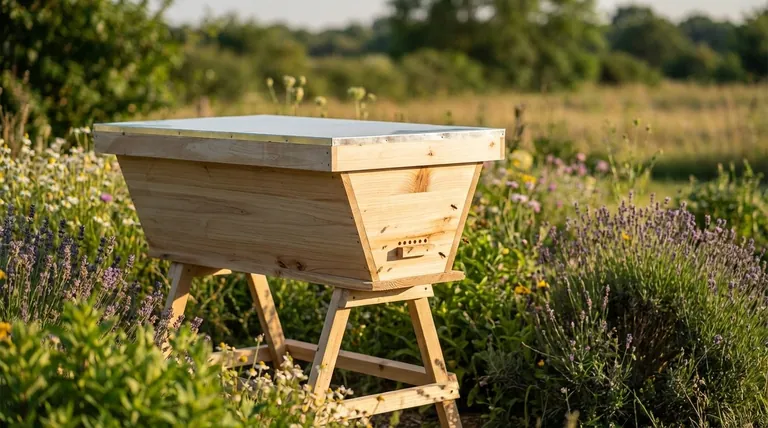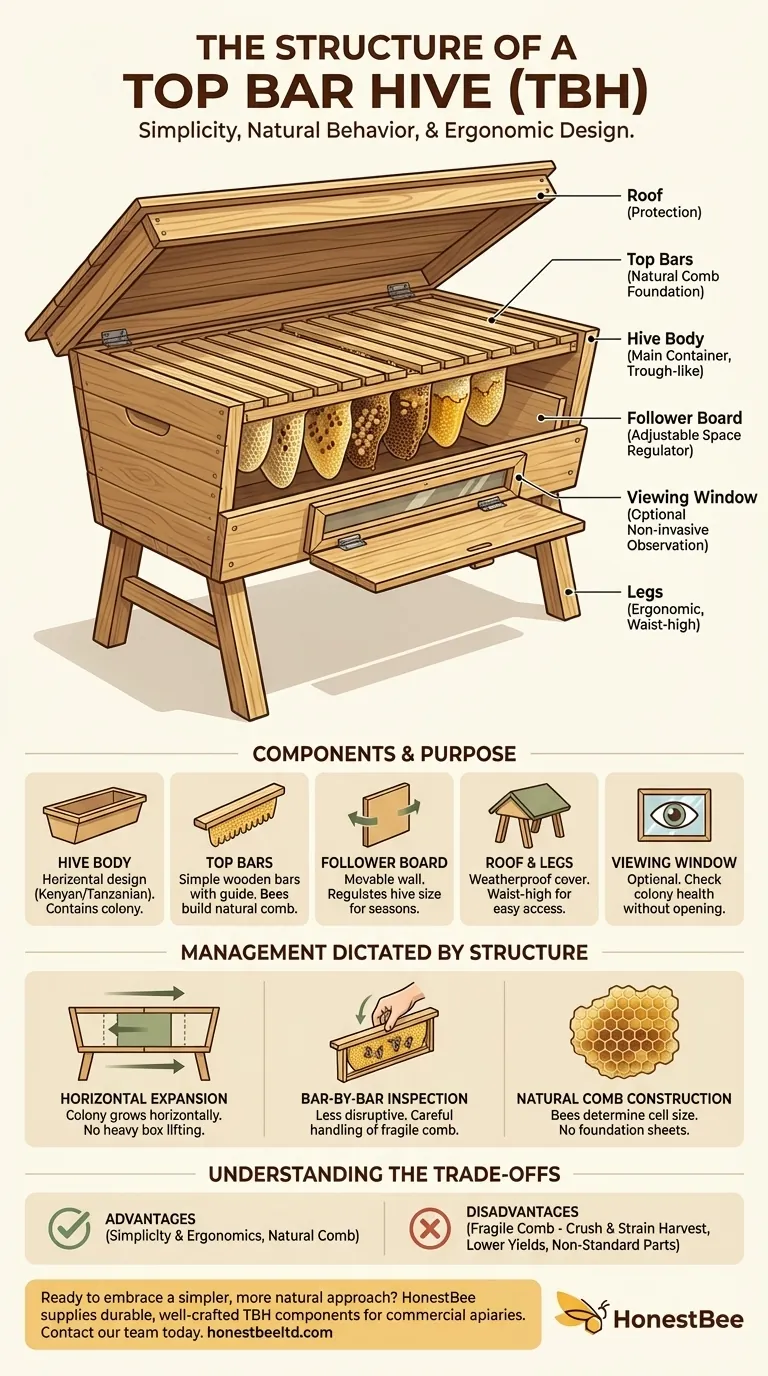At its core, a top bar hive (TBH) is a single, long horizontal box containing a series of removable wooden bars laid across the top. Unlike the vertical, stacking-box design of a Langstroth hive, a top bar hive contains the entire colony—brood, pollen, and honey—in one contiguous cavity. This structure is intentionally simple, promoting natural bee behavior and requiring no heavy lifting from the beekeeper.
The top bar hive's horizontal structure is designed for simplicity and a more hands-off approach to beekeeping. It eliminates the need for heavy lifting and complex components, allowing bees to build their comb naturally as they would in the wild.

The Fundamental Components of a Top Bar Hive
The design philosophy of a top bar hive is "less is more." Each component serves a direct and simple purpose, working together to create a self-contained environment for the bees.
The Hive Body
The hive body is the main trough-like structure that contains the colony. It is typically long and horizontal, designed to sit on legs at a comfortable working height.
There are two common styles: the Kenyan, which has sloped sides, and the Tanzanian, which has straight, vertical sides. The sloped sides of the Kenyan hive are intended to discourage bees from attaching their comb to the hive walls, making inspections easier.
The Top Bars
The top bars are the defining feature of this hive. Instead of the four-sided frames found in other hives, a TBH uses simple wooden bars that sit flush against one another, forming a solid roof over the colony.
Bees build their comb directly down from a guide on the underside of each bar, creating natural, free-form structures without the need for pre-made foundation sheets.
The Follower Board
A follower board is a solid panel, shaped like the hive's internal profile, that acts as a movable wall inside the hive body.
Its purpose is to regulate the amount of space available to the colony. Beekeepers use it to shrink the hive cavity during winter to help the bees stay warm or to gradually expand the space as the colony grows.
The Roof and Legs
The roof is a simple cover that protects the hive from rain, sun, and predators. It can be flat or gabled and is often hinged to allow for easy access without having to set it on the ground.
Legs are a crucial ergonomic feature, raising the entire hive body to waist level. This eliminates the bending and lifting of heavy boxes associated with other hive types.
Optional Feature: The Viewing Window
Many top bar hive designs incorporate a long viewing window on one side of the hive body, usually with a hinged cover.
This allows the beekeeper to perform quick, non-invasive checks on the colony's size, health, and progress without opening the hive and disturbing the bees.
How the Structure Dictates Management
The unique structure of a TBH directly influences how a beekeeper interacts with the colony. The focus is on observation and gradual adjustments rather than large-scale manipulations.
Horizontal Expansion, Not Vertical Lifting
As the colony grows, the beekeeper simply moves the follower board down and adds empty bars. The bees expand the nest horizontally along the hive.
Honey is typically stored at the far end of the hive, away from the brood nest. To harvest, the beekeeper removes a few honey-filled combs from the back, leaving the brood nest undisturbed.
Natural Comb Construction
Because there are no frames or foundation, bees build their comb to their own desired cell size. This is a key principle of "natural" or "treatment-free" beekeeping.
The comb is only attached to the top bar, however, making it more fragile than the comb in a four-sided frame. Inspections must be done carefully, keeping the comb oriented vertically to prevent it from breaking.
Bar-by-Bar Inspections
Inspections are performed by removing and examining one bar at a time. This is far less disruptive to the colony than removing an entire box containing ten frames.
If bees have attached the comb to the hive walls, the beekeeper must gently detach it with a hive tool before lifting the bar.
Understanding the Trade-offs
The simplicity of the top bar hive presents both distinct advantages and clear limitations compared to the industry-standard Langstroth hive.
Advantage: Simplicity and Ergonomics
The TBH is mechanically simple, with fewer parts to buy, build, and store. Its waist-high, single-box design means there is no need to lift boxes that can weigh 50 pounds or more.
Disadvantage: Fragile Comb and Extraction
The free-hanging comb is fragile and cannot be put into a centrifugal extractor for honey harvesting. Honey is typically harvested by crushing the comb and straining the honey out, which destroys the comb in the process.
Disadvantage: Lower Yields and Non-Standard Parts
Top bar hives generally produce less honey than a well-managed Langstroth hive. Furthermore, parts are not standardized across manufacturers, making it harder to find replacement components.
Making the Right Choice for Your Goals
Choosing a hive type depends entirely on your beekeeping philosophy and objectives.
- If your primary focus is natural beekeeping and minimal heavy lifting: The top bar hive is an excellent choice due to its simple, ergonomic design that allows for natural comb.
- If your primary focus is maximizing honey production and using standard equipment: The vertically stacking Langstroth hive is the industry standard and better suited for larger-scale honey harvests.
- If your primary focus is learning bee behavior with minimal disturbance: The top bar hive, especially one with a viewing window, offers a unique and less invasive way to observe a colony's natural development.
Ultimately, the structure of the top bar hive is a direct reflection of a beekeeping style that prioritizes the bee's natural instincts and the beekeeper's ease of use.
Summary Table:
| Component | Purpose | Key Feature |
|---|---|---|
| Hive Body | Main container for the colony | Horizontal, trough-like design (Kenyan/Tanzanian styles) |
| Top Bars | Foundation for comb building | Simple wooden bars with a guide for natural comb |
| Follower Board | Adjusts colony space | Movable wall to regulate hive size |
| Roof & Legs | Protection and ergonomics | Weatherproof cover; waist-high legs for easy access |
| Viewing Window | Non-invasive observation | Optional window to check colony health without opening hive |
Ready to embrace a simpler, more natural approach to beekeeping?
At HONESTBEE, we supply the durable, well-crafted top bar hives and components that commercial apiaries and distributors trust. Our wholesale-focused operations ensure you get the reliable equipment you need to support natural bee behavior and reduce beekeeper strain.
Let's discuss how our top bar hive solutions can benefit your operation. Contact our team today to learn more about our products and wholesale pricing.
Visual Guide

Related Products
- Top Bar Beehive for Beekeeping Wholesales Kenya Top Bar Hive
- Long Langstroth Style Horizontal Top Bar Hive for Wholesale
- HONESTBEE Professional Long Handled Hive Tool with Precision Cutting Blade
- HONESTBEE Professional Multi-Functional Hive Tool with Ergonomic Wood Handle
- HONESTBEE Advanced Ergonomic Stainless Steel Hive Tool for Beekeeping
People Also Ask
- What are the key features of the Kenyan Top Bar Hive? A Guide to Simpler, Natural Beekeeping
- What are the benefits of extra wax production in top bar hives? A Natural Byproduct for Craft & Efficiency
- Which is better Kenya top bar hive or Langstroth? Choose the Right Hive for Your Goals
- What are the labor requirements for a KTBH vs. Langstroth hive? A Guide for Apiary Efficiency
- How should a beekeeper prepare a top-bar hive for overwintering? A Guide to Ensure Colony Survival



















